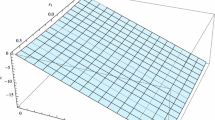Abstract
Following a few words on multifunctions in the mathematical literature, a very brief recall on dual spaces, some preliminary notations and definitions in the introduction, we give some results on those functions in the second paragraph. In the third paragraph, a duality theory in cone-optimization involving multifunctions is developed with the concept of the strong instead of the weak cone-optimality criterium. The results so obtained account for existing ones on univocal vector-function optimization and they hold in spaces of arbitrary dimension.
Similar content being viewed by others
References
Berge C (1959) Espaces topologiques. Fonctions multivoques. Dunod, Paris
Robinson SM (1979) Generalized equations and their solutions, part 1: Basic theory. Mathematical Programming Study 10:128–141
Aubin JP, Cellina A (1984) Differential inclusions, set-valued maps and viability theory. Springer Verlag, Berlin
Klein K, Thompson AC (1984) Theory of correspondances. John Wiley, New York
Castaing C, Valadier M (1977) Convex analysis and measurable multifunctions. Springer Verlag, Berlin
Rockafellar RT (1972) Convex analysis. Princeton University Press, Princeton, New Jersey
Tanino T, Sawaragi Y (1979) Density theory in multiobjective programming. Journal of Optimization Theory and Applications 27:509–529
Nakayama H (1984) Geometric consideration in vector optimization. Journal of Optimization Theory and Applications 44, 4:625–655
Luc DT (1979) On duality theory in multiobjective programming. Journal of Optimization Theory and Applications 27:509–529
Tanino T (1988) Sensitivity analysis in multiobjective optimization. Journal of Optimization Theory and Applications 56, 3:479–499
Giannessi F (1987) Theorems of the alternative for multifunctions with applications to optimization: General results. Journal of Optimization Theory and Applications 55, 2:233–256
Zangwill WL (1969) Nonlinear programming: A unified approach. Prentice Hall, Englewood cliffs, New Jersey
Hogan WW (1973) Point to set maps in mathematical programming. Siam Review 15:591–603
Corley HW (1988) Optimality conditions for maximizations of set-valued functions. Journal of Optimization Theory and Applications 58, 1:1–10
Kawasaki H (1982) A duality theory in multiobjective nonlinear programming. Mathematics of Operations Research 7:95–110
Corley HW (1987) Existence and Lagrangian duality for maximization of set-valued functions. Journal of Optimization Theory and Applications 54, 3:489–501
Jahn J (1983) Duality in vector optimization. Mathematical Programming 25:343–355
Kouada I (1994) Sur la dualité en optimisation vectorielle convexe. Recherche Operationnelle/Operations Research 38:255–281
Jahn J (1986) Mathematical vector optimization in partially ordered linear spaces. Verlag Peter Lang, Frankfurt-Am-Main
Laurent PJ (1972) Approximation et optimisation. Hermann, Paris
Schaefer HH (1971) Topological vector spaces. Springer Verlag, Berlin
Rudin W (1973) Functional analysis. Tata McGraw-Hill Publishing Company LTD, New Delhi
Rudin W (1966) Real and complex analysis. McGraw-Hill Book Company, New York
Schwartz L (1970) Analyse, topologie générale et analyse fonctionnelle. Hermann, Paris
Aubin J (1981) Contingent derivatives of set-valued maps and existence of solutions to nonlinear inclusions and differential inclusions. In: Nachbin L (ed.) Advances in Mathematies, Supplementary Studies, Academic Press, New York, pp. 160–232
Tardella F (1989) Some topological properties in optimization theory. Journal of Optimization Theory and Applications 60, 1:105–116
Mangasarian OL (1969) Nonlinear programming. McGraw-Hill Book Company, New York
Kouada IA (1994) Technical note on duality in linear vector maximization. Recherche Operationnelle/Operations Research 28, 2:203–207
Hiriat-Urruty JB (1985) Images of connected sets by semi-continuous multifunctions. J. Mathematical Analysis and Application 111:407–422
Author information
Authors and Affiliations
Additional information
The author is grateful to the refuree's helpful suggestions.
Rights and permissions
About this article
Cite this article
Kouada, I. Upper-semi-continuity and cone-concavity of multi-valued vector functions in a duality theory for vector optimization. Mathematical Methods of Operations Research 46, 169–192 (1997). https://doi.org/10.1007/BF01217689
Received:
Revised:
Issue Date:
DOI: https://doi.org/10.1007/BF01217689



